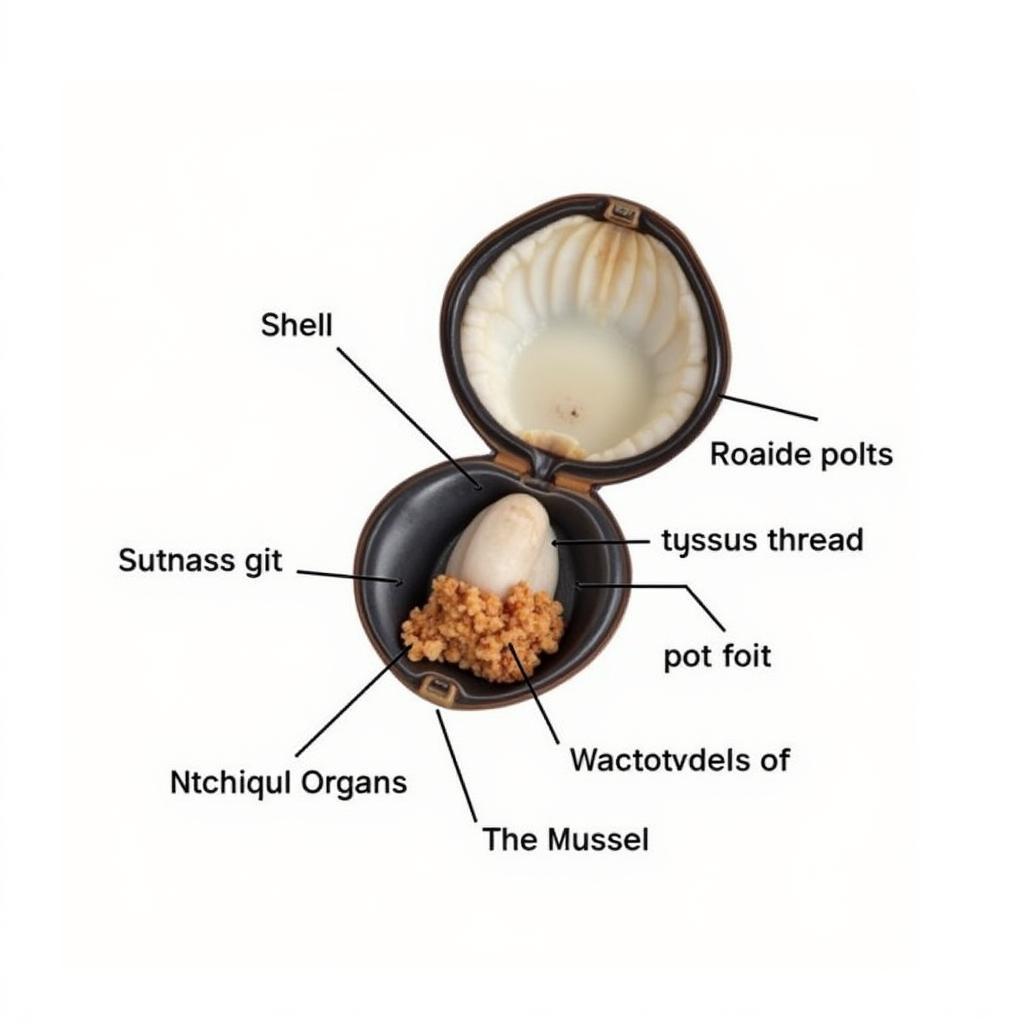The term “fan mussel” might seem a bit strange at first. Is it a mussel that’s a fan of something? Actually, it refers to a fascinating group of saltwater clams known for their unique fan-shaped shells. These bivalve mollusks, scientifically classified under the family Pinnidae, are found in warm, shallow waters around the world.
The Anatomy of a Fan Mussel: More Than Just a Pretty Shell
 Fan Mussel Anatomy Diagram
Fan Mussel Anatomy Diagram
While their name highlights their distinctive shell, fan mussels possess other intriguing characteristics:
- Byssus Threads: These strong, silky fibers anchor the mussel to the seabed, securing it against currents and waves. These threads, historically valued for their strength and golden hue, were once woven into luxurious fabrics.
- Filter Feeders: Like other bivalves, fan mussels are filter feeders, drawing in water and extracting microscopic plankton and organic matter for sustenance. This feeding behavior plays a crucial role in maintaining water clarity and ecosystem health.
- Ecological Importance: Fan mussels provide habitat and shelter for a variety of marine organisms. Their shells can become encrusted with other creatures, adding to the biodiversity of their surroundings.
The Global Distribution and Habitat of Fan Mussel
Fan mussels are found in tropical and subtropical waters across the globe, thriving in a variety of habitats including:
- Seagrass beds: The dense network of seagrass roots offers protection and stability for these anchored creatures.
- Sandy bottoms: Fan mussels can wedge their pointed ends into the sand, securing themselves in these dynamic environments.
- Mangrove forests: The sheltered waters and rich sediment of mangrove ecosystems provide favorable conditions for fan mussels.
Threats and Conservation of Fan Mussels
Despite their ecological importance, fan mussels face numerous threats, largely due to human activities:
- Habitat destruction: Coastal development, dredging, and destructive fishing practices degrade and destroy crucial fan mussel habitats.
- Pollution: Agricultural runoff and industrial discharge introduce harmful pollutants into the water, negatively impacting fan mussel health and survival.
- Overfishing: In some regions, fan mussels are harvested for their meat, shells, and byssus threads, leading to population declines.
Conservation efforts aimed at protecting fan mussels include:
- Habitat restoration: Projects focused on restoring seagrass beds and mangrove forests can provide refuge for fan mussels.
- Pollution control: Implementing stricter regulations on industrial discharge and agricultural runoff is essential for improving water quality.
- Sustainable fishing practices: Promoting responsible fishing gear and quotas can help prevent overexploitation of fan mussel populations.
The Cultural Significance of Fan Mussels
Throughout history, fan mussels have held cultural significance in various societies:
- Ancient Crafts: As mentioned earlier, the byssus threads of certain fan mussel species were woven into a rare and valuable fabric known as sea silk.
- Food Source: In some cultures, fan mussels are harvested and consumed as a food source.
- Decorative Items: Their unique shells are often collected and used in jewelry making or as decorative items.
Conclusion
The fan mussel, a seemingly unassuming creature, plays a vital role in marine ecosystems. Understanding their biology, ecological importance, and the threats they face is crucial for ensuring their conservation. By appreciating these fascinating bivalves, we can contribute to the health and biodiversity of our oceans.
FAQs about Fan Mussels
1. What do fan mussels eat?
Fan mussels are filter feeders, meaning they strain microscopic organisms and organic matter from the water. Their diet consists primarily of plankton, algae, and other tiny particles.
2. How long do fan mussels live?
The lifespan of a fan mussel varies depending on the species and environmental conditions. Some species live for a few years, while others can survive for a decade or more.
3. Are fan mussels endangered?
The conservation status of fan mussel species varies globally. Some populations are thriving, while others are facing threats and declining numbers.
4. Can you eat fan mussels?
Yes, fan mussels are edible in some regions. However, it’s important to be aware of local regulations and sustainability concerns before harvesting or consuming them.
5. How do fan mussels reproduce?
Fan mussels reproduce sexually through external fertilization. They release eggs and sperm into the water, where fertilization occurs. The larvae then develop into free-swimming veligers before settling and attaching to a suitable substrate.
Need More Information on Fan Mussels?
If you have more questions or need further assistance, please don’t hesitate to contact us:
- Phone: 0903426737
- Email: fansbongda@gmail.com
- Address: Tổ 9, Khu 6, Phường Giếng Đáy, Thành Phố Hạ Long, Giếng Đáy, Hạ Long, Quảng Ninh, Việt Nam
Our dedicated customer support team is available 24/7 to assist you.


